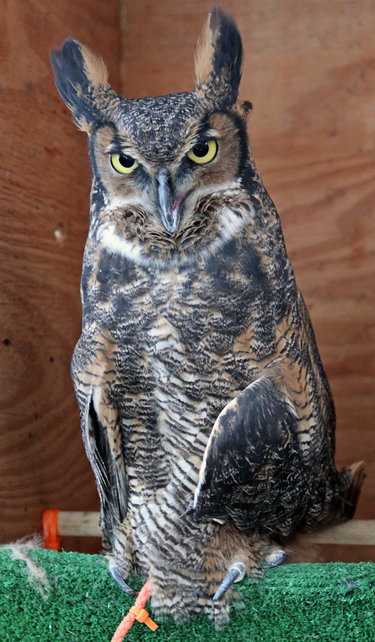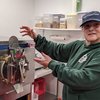Under her wing: Perry protects birds that can’t fly, shares her knowledge with others
The Enterprise — Elizabeth Floyd Mair
Socrates, a great horned owl who cannot fly, examines a reporter at Whispering Willow Wild Care, a not-for-profit wildlife education center in Guilderland where he lives. His aviary was built as an Eagle Scout project by veterinarian Dr. Michael McCarthy of Voorheesville and his son, Perry says; they also raised the funds for the materials.
GUILDERLAND — Joyce Perry, who runs Whispering Willow Wild Care on Carman Road in Guilderland, has about a dozen disabled wild birds in cages in a hallway in her home’s lower level, where they will stay until spring when they can return to their outdoor aviaries.
Perry, 74, was a social worker until she retired about two decades ago. Now, instead of helping people in need, she opens her home to birds that will never be able to return to the wild because of injuries or blindness, often the result of car crashes.
She brings her birds to schools, libraries, festivals, and senior assisted-living facilities — “Everywhere,” she says — to show them and tell their stories. This year alone, her not-for-profit organization did 73 programs.
Perry is licensed as a wildlife educator by the New York State Department of Environmental Conservation and the United States Fish and Wildlife Service, she said.
Among the birds in her care are Vincent Van Crow, who likes to have his beak rubbed and who periodically calls out, “Hello! Who’s that?” He fell out of a nest as a baby, says Perry. His favorite long-time volunteer, Mal Muratori, is trying to teach him to say “I love you,” but so far, he’s not cooperating.
Vincent, like the other birds she uses for presentations, wears anklets with attached jesses, or straps; leashes connected to educators’ gloves can be hooked onto these. “The birds need to be under our control at all times,” Perry said.
She brought Vincent Van Crow inside recently because he was shivering. Also, his outdoor cage needs to be rewired and that can’t be done until spring. He likes it inside, but he will go back out, she says, determinedly.
“Kids love him,” Perry says. “When we go to schools, kids can also throw him Cheerios and he catches them. He’s a showman.”
Perry thinks it is important to educate particularly future generations. “So if they see them up close and personal,” she says of her birds, “they will then think about helping to save their habitat, and about learning to live with our wild neighbors.”
Animals come to educators like Perry from around the country. If a facility has a bird that has been deemed unreleasable by a veterinarian, she says, the bird is put on a list; educators can then look at the list and request a particular animal.
Perry also has a vulture named Virgil, two gray Western screech owls, a red morph screech owl, and a broad-winged hawk named Hinon after the Iroquois god of thunder.
On Friday, an American kestrel briefly seizes the chance to escape down the hall when Perry opens his cage. Muratori goes over to the errant bird of prey, speaks softly to it, and deftly recaptures it.
Muratori, a senior at Paul Smith’s College in the Adirondacks, is studying fisheries and wildlife science and has been volunteering with Perry since 2014.
Feeding all of these creatures is expensive work, according to Perry, funded by grants and donations. They eat frozen food — mice, rats, chicks, and quail.
The mice alone cost $15,000 a year now, she said, although they used to come free to area rehabilitators and educators from a laboratory; that changed when the company was taken over by new management. Of the change she says, “That was a big hit. For all of us. We’re all hurting.”
In days’ past, Perry was also a licensed rehabber, but now, “Let the young ones do it,” she says.
“I used to do everything,” she continues. “Skunks, raccoons, coyotes. I had little baby beavers in the bathtub. Not any more, though.”
Looking at snapshots on a wall of some of the animals she has rehabbed, Perry says, “Opossums are my favorites.” But a minute later she says the same thing about porcupines. Outside, by the ravens’ aviary, she notes that ravens are “the smartest bird in the world,” and calls them her favorites.
“They’re all my favorites,” she admits.
Ravens and crows, she says, can recognize and remember human faces. “If you’re been mean to a crow, they’ll remember you,” she says.
There are two wild ravens that come by every day, says Perry, to peer through the screened aviary at her ravens, who are named Edgar Allan and Sweet Lenore. (Edgar Allan Poe wrote a poem about the “sweet Lenore.”)
Outside are the various birds who don’t mind the cold, including the snowy owl, Noel, who arrived two Christmases ago after being hit by a train. Perry also has barred owls, a barn owl, and great horned owls.
It’s a lot harder for Perry to open the doors of the aviaries in winter; her arthritis bothers her. She is happy for help from her younger volunteers. She is fortunate to have many great volunteers, but is always looking for more — “especially builders,” she says.
Perry’s sanctuary had a moment of unexpected notoriety this fall when a volunteer left an emu’s aviary unlocked and the large, flightless bird, named Sheriff Cody, went for a stroll down the middle of busy Carman Road. The emu has since gone to an area rescue with barns and many acres. “Those birds need to have room to run around,” says Perry.
Asked if she has a husband around, Perry answers, “I’ve been divorced 100 years.” She pauses for a beat and looked down the hallway lined with cages. “Can you imagine some man wanting to live with me?” she quips.
Perry has no plans to retire from this second career.
“I’m gonna drop dead with a bird on my arm,” she says with a smile.



